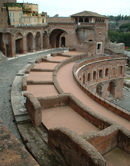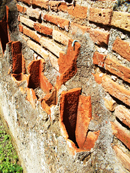|
Pax
Romana |
Christendom
Rapacious taxation, rather
than barbarians, destroyed most Roman towns, abandoned as their citizenry
dispersed across the countryside. Though taxed more than ever, urban
residents received little in return.
For generations, the
ostentatious patronage of the urban elite had been lavished on civic
amenities. But in
the late Roman world that patronage went, instead, into
churches, monasteries, relics, holy men and pilgrimages.
The
urban aristocracy increasingly abandoned the towns as a way to
avoid their civic responsibilities. No longer spending money
on
maintaining
public buildings, a moated manor or a bishop's palace for their own exclusive
use became the residence of choice.
In a further step, small-holders sold themselves
into serfdom with the local 'baron' to avoid more immediate dangers.
Ruined
The Christian destruction
of pagan temples tore the heart out of many cities which, over
the course of centuries, had grown up around the sacred precincts – rather
as medieval villages would grow around the parish church.
In Rome, as in other
cities, the central forums, desolate and dangerous, were abandoned
as a tiny Christian 'new town' grew up in the old suburbs,
around a church or bishop's residence. Towns
contracted, and farmlands were reclaimed by the wild.
Obvious
conveniences, such as glass windows in domestic housing, disappeared
for a thousand years. Floors reverted to the common earth;
the finely laid mosaics and tiling beyond the wit of any Christianized
artisan.
In a perverse caricature
of history, the Church maintained that the original "perfect" Earth had indeed been ruined – but
it was "Original Sin" that had done the damage!
Squalor
Christian
Europe built no sewers or aqueducts to flush the filth and squalor
from the towns.
Ecclesiastic
buildings might take the form of a great rural estate, seat of
the local pontiff, but towns were a chaos of confusion, crisscrossed
by dingy lanes and stinking alleyways.
Not until the frequent epidemics in the
19th century made males of military age unfit to serve
in imperial armies did European governments address the issue. |
Village People
The village, not the city, characterised the Christian
empire.
Where the rump
of a formerly great city continued into the Middle Ages,
none had more than 50,000 residents. Where part of a city
remained in use as a shanty town, urbanisation did not extend
beyond the Roman walls until the
19th century.
Towns
in reality were chaotic, overgrown villages.
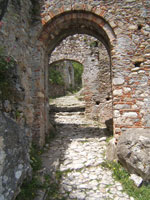 |
Narrow cobbled streets, unsuitable for carriages, signalled the end of regularity and the grand thoroughfares of the early empire. Some of the alleyways were no more than 4 feet wide and passed beneath buildings, making sanitary conditions difficult if not impossible.
Byzantine Mystras (Greece). |
|
|
|
Towns 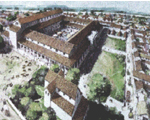
Verulamium the Romans knew |
Roman
civilization was essentially urban. Three technologies made its great
cities possible: huge, grain-carrying
merchant ships; concrete; and efficient water supplies.
Roman engineers improved
on the Greek pillar-and-beam design with the load-spreading arch.
Arches and vaults, made of brick-faced concrete, allowed Roman architects
to build
with great visual variety and to an immense size. |
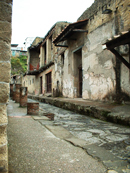
Herculaneum |
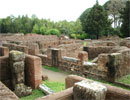
Town planning at Ostia |
Iron-reinforcements
and a cement called pozzolana (lime and volcanic ash) enabled the
Romans to build with pre-stressed concrete – and underwater. |
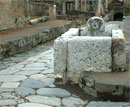
Fresh water flowed freely
from this public fountain at Herculaneum |
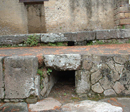
Road drainage, Herculaneum |
|
Fast
Food
Wine and bread shop, 1st century Pompeii. |
|
Shopping
Mall
Roman shopping mall on
6 floors – built early in the 2nd century. (Trajan's
Market, Rome)
Nothing like it would be seen again until the 20th century.
|

Aqueduct, Segovia |
FRESH
WATER
Roman Aqueducts
Impressive by any standards – dressed
stone without mortar and maintaining a steady gradient of 0.4%.
400 miles of piping supplied 1st century Rome with 900 million
litres of water per day.
The Roman system of water supply was not equalled anywhere until
the 19th century. |

Aqueduct, Pont du Gard
- Nimes |
SANITATION
Even on the frontiers of the empire, the common soldier
in the Roman army had fresh water and the use of flushing lavatories.
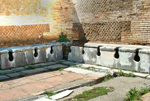
Public toilet – Ostia, Italy |

Lavatory – Housesteads fort, Hadrian's Wall.
|
|
A
THRONE FOR THE QUEEN !
Making a departure from tossing human excrement from a pot, Sir
John Harrington, godson to Queen Elizabeth, made a flush toilet for
himself and his godmother in 1596. Harrington was teased by his friends and never made another one although
he and the Queen continued to use the one he did make.
Two hundred years later
Alexander Cummings reinvented the flush toilet – two thousand
years after the Romans!
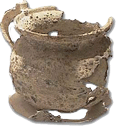 Elizabethan chamber pot. Elizabethan chamber pot.
|
|
|
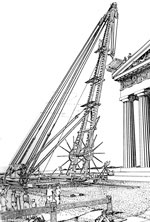
Vitruvius's massive crane |
CONSTRUCTION
Cranes and pulleys were in use from
the 6th century BC. Vitruvius, chief
engineer of Augustus, wrote an encyclopedic work "De
architectura" which became the standard reference book for Renaissance
architects and engineers – fifteen centuries after his death. |
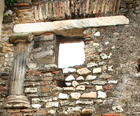
Jerry-built Dark Age
In cannibalising the remnants of imperial structures Christian
artisans had little regard for principles of architecture! |
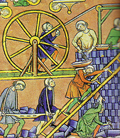
Building – Medieval
style.
After 15 centuries, Renaissance
architects turned to Vitruvius's ancient Roman manual as their guide! |
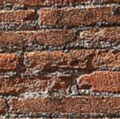
Roman brick |
BRICK & TILE
The Romans took
the art of brick making to the far reaches of the empire. So long as
suitable clay,
sand and water
was available, tiles and bricks were manufactured on-site or in kilns
nearby.
Flatter than modern bricks Roman bricks were seldom more than 2 inches
thick. Today they are practically as sound as when they were made, fifteen
centuries ago.

Polychromatic marble floor, Hadrian's Villa, Tivoli (2nd century
AD) |
The grandeur of antiquity becomes a 1000-year quarry
During the dark centuries of Christendom
the art of brick and tile making was almost entirely lost in Europe.
In England brick making was practically unknown until the time
of Henry VIII.
Medieval
church builders simply helped themselves to the stone, tile,
carved columns and other decorative features freely available
from the ruins of antiquity.
Thus,
for example, the nave of St. Alban’s Abbey is largely
built of Roman bricks from Verulamium.
The
supply lasted over a thousand years. When it finally gave out,
the Christian builders reverted to flint with lime mortar,
a crude substitute.
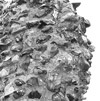 |
Flint wall, Thetford Priory, England |
|
|

Roman roof tiles |
Villas & Agriculture
|
|
| |
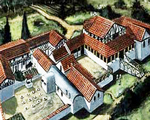
Roman villa |
The Roman villa was more than a home for
a rich family. It was the centre of an 'agribusiness', producing food
for the army, neighbouring towns and export.
It was also a taxable unit,
with tax levied on acreage.
Decorated
with mosaics, painted wall-plaster and exotic statuary a villa
proclaimed the owner’s taste, knowledge of the classics and
obvious wealth. |
The villa had been an integral part of a money economy. When trade and urban life collapsed
the great villas followed suit.
As Europe's population
fell, farmlands were reclaimed by the wild.
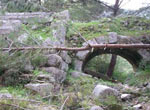
Villas, like everything
else, were robbed out for their tiles and bricks. For a century or two, part of a villa may have remained
occupied but then maintenance became impossible.
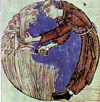 |
"For
more than 1000 years after the fall of Rome there was little
significant change in agricultural
practice."
– Williams (The Triumph
of Invention, p198) |
|
|

Roman plough (mosaic)
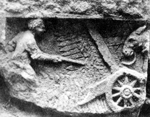
Roman harvesting machine
|
The Romans introduced the iron-bladed plough to northern Europe, and mounted it on wheels.
The Romans also introduced
into the local diet carrots, peas, apples, pears, apricots, turnips,
coriander and asparagus – and the idea
of a 3-course meal! They also took the cultivation of the vine into conquered
lands.
Lucius
Columella, a Roman soldier
and farmer of the 1st century, wrote extensively on agriculture, viniculture
and animal husbandry
('De re rustica').
|
Bridges
|
|
|
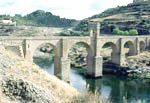
Roman bridge, Alcantara, Spain |
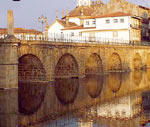
Roman bridge, Chaves, Portugal
After two millennia Roman bridges are still serviceable. |
After the fall of Rome bridge builders
reverted to the use of wood and many a medieval bridge
went up in flame.
Wood was
only superseded – by iron and steel – in the early Industrial
Revolution.

Ponte
Vecchio (Italy) – stone now but for centuries wooden |
|
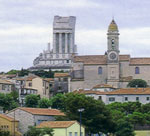
Tropaeum
to Augustus – La Turbie, France |
MONUMENTAL ARCHITECTURE
At half
its original height the Trophy of Augustus (6 BC), built to symbolise
the Romanisation of Gaul, dwarfs the medieval church built more than
1500 years later from stone pillaged from its structure.
Monks
from Lérins
tried their hand at destroying the edifice in the 8th century. Louis
XIV had another go with explosive in the 18th century. |
Post-Roman Squalor
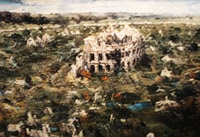
Places like 6th century Canterbury (artistic impression,
above) show no evidence of destruction by 'barbarians.'
They seem to have been abandoned a few years prior to their
occupation by the opportunistic Saxons. Within the redundant
circuit of a Roman wall a few serviceable buildings were pressed
into use by hierarchs of the church. A shanty town of wooden
buildings, chaotically assemble amidst the ruins, housed the
remnants of a depleted population. Christ Ruled.
Abandoned palace
becomes a Town
In the 7th century Christian
refugees from the city of Salona (Croatia) moved into the retirement
home of their old pagan nemesis – Diocletian – and
created the town of Split. They carved a few crosses into the stonework.
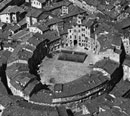 |
Recycled amphitheare
Lucca (Italy). The 1st
century amphitheatre was converted into a fortress during
the Gothic wars of the 6th century and became what was left of the town. After two millennia the
Roman origin of the 'piazza' is still very apparent.
|
|
|
|
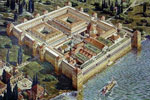
Diocletian's
Palace in its heyday – about 30,000 square metres.

Lateran Palace – a late Roman basilica which stood for a 1000 years.
The palace had belonged to Constantine's wife – before he ordered her murder.
|
Sacred
Space
|
|
| |

Roman Temple. This classic
beauty survived thanks to Mussolini!

That hero of early Christian
scholarship "the Venerable Bede" records that the 9 metre hole in the dome
of the Pantheon (the 'oculus') was made by the Devil fleeing the building.
Must have
worked a treat in selling those bones to gullible pilgrims! |

Pantheon – unsurpassed
masterpiece.
Hadrian, enthusiastic architect as well as emperor, prepared much of
the design.

At
43 metres the Pantheon's dome is larger than St Peter's and was not surpassed until
1960. |
Hodgepodge
The
finest sacred architecture of antiquity was destroyed by
gangs of Christian monks "who alone had time and inclination
to execute such laborious destruction" – Gibbon.
What remained
was patched up and consecrated to the Christian god.
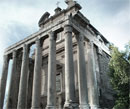 |
Pagan temple
on the outside, Christian Church within.
(Forum, Rome).
|
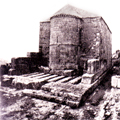 |
Half as Good? Using
the foundations of a destroyed temple to Demeter the Christians built
a much smaller church
for 'St Biagio' (aka 'Blaise') – an 8th century fiction.
(Agrigento,
Sicily)
|
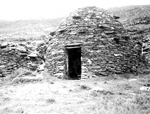 |
Not
quite the Pantheon – 7th
century Christian Monastery.
Built 500 years
later than the Pantheon by Christian monks.
(Skellig Michael, Ireland)
|
|
|
|
The Pantheon owes it survival
to the groveling of Pope Boniface IV to the tyrant usurper in Constantinople,
Phocas. The grateful emperor gave the pope the temple in 609. Boniface
promptly dedicated the structure to 'Mary and the Martyrs' and filled
it with 28 cartloads of bones from the catacombs. Heap Big Magic.
In
the 16th century Pope Urban VIII (Maffeo Barberini) helped himself
to bronze panels from
the Pantheon for use in St. Peter's and also to cast cannons,
which he installed on the roof of Hadrian's mausoleum.
"What the barbarians
spared the Barberini destroyed."
– Pasquino.
Infamous for his prodigious
extravagance and nepotism it was Urban VIII who condemned Galileo. |
|
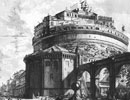
Hadrian's mausoleum
About this reassuring hulk huddled medieval Rome – barely
30,000 impoverished inhabitants.
In the heyday of the
caesars, the city had housed more than a million people. |
Tomb
Robber
Built by Emperor Hadrian
as his final resting place, the tomb was converted into a papal fortress in
the 6th century.
Re-styled as the "Castel
Sant' Angelo" (because a plague-ending angel had hovered there according
to Pope Gregory), this massive edifice of
paganism was later connected to the Vatican by a secret passage, thus
providing the popes with a convenient hideaway.
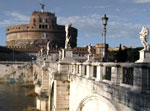
|
The
bridge linking Hadrian's mausoleum to the city, Pons Aelius (aka Ponte
S. Angelo) from the end of the 17th century has sported Bernini's
'angels.'
But from 1480 AD it had been lined by a row of gallows displaying headless corpses – no
doubt, the godless.

Castle? No,
actually it is the palace of the Bishop of Wells (Somerset,
England).
This moated fort was built
by
the "shepherd" to
protect himself from the fury of his "flock" – the
ruthlessly exploited peasantry. |
|
Civic
Amenities
|
|
| |

Amphitheatre – Nimes
Amphitheatre – Arles
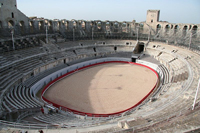
|
There had been well over 250 amphitheatres in the Roman empire.
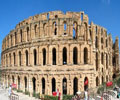
Thysdrus (El Djem) Tunisia |
Christendom – dour & cruel
No
amphitheatres– just
a field for ‘jousting.’ No stadia for spectacles,
just the debasement of its worst aspect, tormented animals in
bear pit and pen, the sport of cruelty.

The grand forums, multi-story ‘supermarkets’ of
antiquity, found a pale reflection in the village fair, held under the auspices of the church on saints' days. |
|

Roman Gymnasium, Sardis
(Turkey) |
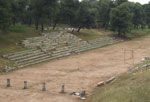
Stadium at Epidaurus, Greece |
Christendom – a sickly world
In
the sick world of Christendom, no gymnasia were available for
the refinement of physical prowess.
The fine
basilicas built by the legions
themselves
became
the very
structures pressed into new use as sanctuaries of the Faith.
"By the 380s
nothing more is heard of the civic gymnasium and its officials
... The physical side of education languished in a Christian
environment: in the cities it had been linked with naked exercise,
paganism and consenting homosexuality.The eventual collapse
of the gymnasia, the focal point of Hellenism, more than any
other single event brought in the Middle Ages."
– Robin Lane Fox (Pagans & Christians,
p670) |
|
The Baths
|
Medieval
squalor
Public
baths for leisure and hygiene was unheard of in Christendom – water
was too precious to use for anything except drinking and cooking,
so people rarely bathed.
Unwashed clothes were
worn every day, with more rags piled on top in colder weather.
Everywhere, fleas and
flies, excrement and filth, stagnant and contaminated water of
every description.
This
was the great age of lice and rats, of plague and epidemic! Cleanliness next to godliness?
No
schools of rhetoric and learning, no libraries, no law
courts ...
Where
once fine forum porticoes carried the towering statuary of
the Roman elite, confident and dynamic, now simply the cross, ironically
symbolic of human suffering. |
|
"Nero
provided the first public baths ... As dynasties succeeded one another,
the baths became larger and
more luxurious
... it became the custom to linger there for hours on end, so that they
became the social centres, clubs and cafés of Imperial Rome."
– Grimal (Rome
of the Caesars, p21)
|
|

Hadrianic baths – Leptis Magna |

Baths, Herculaneum – ready for use after 20 centuries! |
|
Roman
central heating was not only under floor heating, it included wall
vents as well – an all-round
solution unknown even today!
|
| |
|

Colosseum: the quintessential symbol of Roman culture. |
The
Flavian amphitheatre – over
620 feet long, 525 feet wide and 157 feet high.The cement foundations
alone were 23
feet thick.
According to the "Chronographia" of 354 AD, it could
contain 87,000 spectators, about half of them sitting. |
End of the Games?
Gladiatorial
contests and blood sports – like
slavery itself – continued long after the triumph of Christianity.
Only war and poverty brought them to a close – NOT 'Christian
compassion.'
The last shows seen in the Colosseum were early in the 6th century,
during the reign of the Gothic king Theodoric, a Christian monarch.
After Theodoric's death, Justinian invaded Italy and in the general ruin of
the peninsula grand entertainment of all kinds disappeared.
|
The Colosseum, like other great structures, was scavenged
for building material for centuries.
Cardinal Farnese (1534-49) used
4000 men in a single day to pillage material. Cut stone from the Colosseum
was used in St. Peters, the Lateran, Palazzo Venezia, even in the Tiber's
river defences.
Looting of the arena only stopped in the 18th century when the popes
found it more profitable to turn the ruin into a 'holy site,' honouring
supposed martyrs.
|
What
Martyrs?
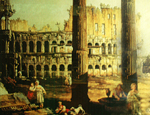 |
The
idea of Christians martyred in the Colosseum was unheard of before
the 17th century. Admits
the Catholic Encyclopedia, there are "no historical grounds" for
the supposition.
Throughout the Middle Ages the Colosseum
was never on the list of sites of veneration, being nothing more
than a huge quarry and sometime fort.
|
|
|
|
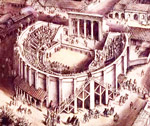
Roman Theatre (Verulamium)

The
Roman theatre had to compete with a great many other spectacles: circuses, race tracks, amphitheatres. |
Theatres were actually more numerous than the more spectacular amphitheatres. Rome itself
had several.
The first permanent Roman
playhouse was Pompey's Theatre, built in 55 BC.
Larger than the Greek
prototypes, the Romans built immense, freestanding, open-air theatres,
seating over 15,000 spectators.
General
supervision of the theatre came from an official called an ædile,
but the productions themselves were private investments – in some
cases, as part of a political contest.
Coarse buffoonery, satire, indecent humour, burlesque and wrestling
were standard fare. Often, one actor spoke the lines while a second mimed
with exaggerated gestures. Decorative masks, costumes and dancing completed
the show.
|
The Church,
competing in the same crowded market place as the theatre, condemned
the "unhappy
slaves of a cruel voluptuousness."
The last recorded performance in Rome took place in AD 533 during the
reign of Theodoric, the Gothic Christian king.
In Constantinople, the actress 'Theodora from
the brothel' ('ek tou porneiou' – Bishop
John of Ephesus) married a prince and became a most pious empress. The theatre which had given her a start came under a cloud and in the 7th century
was banned throughout the east.
In
the desperate and cruel centuries that followed the fall of Rome
public entertainment sank to the level
of 'street
performances' of various
kinds – jesters, minstrels, jugglers. These hapless souls, outside
the control of the church, were often beaten or jailed for their efforts.
No
theatres were raised for drama and vaudeville; at best, horse-drawn
carts trundled between towns, enacting Christian pageants.
Western theatre reappeared
in the 10th century as a church-sponsored substitute for literacy.
Small booths (called 'mansions'), represented
places such as Jerusalem, Heaven, and Hell (the most elaborate!) These
were set up in churchyards or market squares and both the players and
the audience moved about.

A Christian pageant wagon or 'mobile stage,' outside a church. |
|
Christian
Science?
For
fifteen centuries the only ‘great’ architecture in
Europe was the twin bastions of oppression – the castle and
the church. However, a thousand years did produce two
great Christian 'inventions' ... |
671 Byzantine Kallinikos of
Heliopolis invented a napalm-type weapon – "Greek
fire."
This secret weapon was first used against
the Saracens at the Battle of Cyzicus.

Well, actually, it seems
Kallinikos was a Jew in the employ of the Christians.
|
14th
century – and Christian Europe 'discovers' another marvel – gunpowder. Cannons and pistols follow.
Now we can REALLY have Holy
War ...
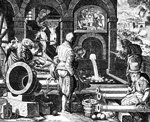
Well, actually, the Christians
learned of an ancient Chinese discovery from several centuries
earlier. The first successful casting of a European bronze canon is
usually attributed to a German – a friar Berthold der
Schwarze. |
 Lost
World – Civilization Erased
by Piety and Fanaticism (Part
Two) Lost
World – Civilization Erased
by Piety and Fanaticism (Part
Two)
Sources:
K.D. White, Greek & Roman Technology (Thames & Hudson,
1984)
Trevor Williams, The Triumph of Invention (Macdonald Orbis, 1987)
Thomas Crump, A Brief History of Science (Robinson, 2001)
John Gribbin, Science, A History (Penguin, 2003)
Lisa Rosner(Ed.), Chronology of Science (Helicon, 1999)
F. G. Bratton, A History of the Bible (Robert Hale 1961)
Thomas Cahill, How the Irish Saved Civilization (Doubleday, 1995)
Frank Delaney, A Walk in the Dark Ages (Fontana, 1988)
Henri Pirenne, Medieval Cities (Princeton, 1952)
| |
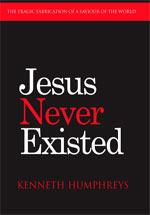
|
 |

|

|
Some fifty articles are now available as a book.
For your copy order:

|
|
Copyright © 2004 by
Kenneth Humphreys.
Copying is freely permitted, provided credit is given to the author and no
material herein is sold for profit.
|
|

